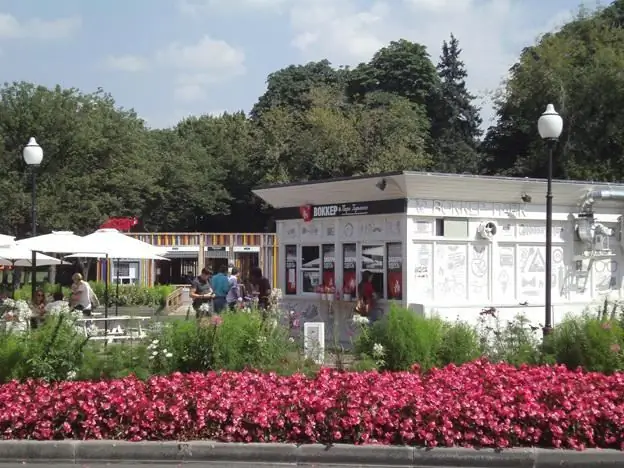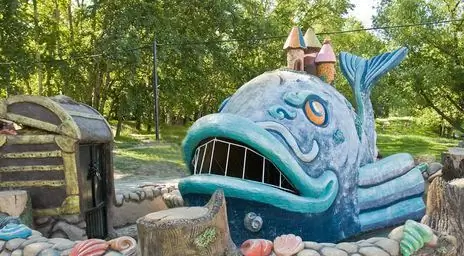- Author Harold Hamphrey [email protected].
- Public 2023-12-17 10:06.
- Last modified 2025-01-24 11:10.
Park "Silvia" in Gatchina is a separate part of the Palace Park and is located in the north-west direction from the Grand Palace. At the moment, "Sylvia" is a visited park, which is part of the museum-reserve in the city of Gatchina.
History of Creation
The park with the romantic name "Sylvia" was founded by order of the Grand Duke Pavel Petrovich and was created over the course of eight years (from 1792 to 1800). The Grand Duke was inspired by a trip to Europe, where he and his wife visited the parks of Chantilly. The desire to recreate something reminiscent of French parks prompted Pavel Petrovich to set up a similar square in Gatchina. For this purpose, the estate of Count Grigory Orlov was chosen, who was a great hunter and kept a park for pheasants on his estate.
This place was a forest with groves, clearings and a building for keeping pheasants, located on the banks of the Kolpanka River. And although the construction of gardens, parks and architectural structures “on the model” was quite common at that time, the Sylvia park (being mostly borrowed) was created taking into account local natural features and traditionscountries. The talented gardener and park builder James Hecket and the architect Vincenzo Brenna worked on the creation of "Sylvia".
Park layout
In addition to the borrowed French name, Sylvia Park also inherited a strict geometric scheme with a radial three-beam. Such a composition was quite popular in the park complexes of Europe in the 17th-18th centuries.

Three main alleys radiate from the main Sylvia Gate. The left alley leads to the Black Gate, the middle alley leads to the complex of the former dairy farm located on the banks of the Kolpanka River, the right alley leads deep into the park, to the Ptichnik. The main alleys are crossed by three almost parallel footpaths. The one closest to the Sylvius Gate leads to the Palace Park and the Zverinsky Gate, while the far one leads to a cascade with a gateway and a ruined bridge. Along the entire perimeter, the park area is covered by a ring road that connects the entire composition of alleys.
Architecture of the complex
Sylvia Park, together with a perimeter fence, has a total area of 17.5 hectares.

It is separated from the adjacent Palace Park by a stone wall with a gate bearing the mask of the forest spirit Silvanus.

The Sylvia Gate is one of the main attractions of the park, the result of the work of the architect Brenna. The meandering river Kolpanka separates "Sylvia" and the park "Zverinets". On the banks of this river are farm buildings andpoultry houses that complement the landscape, beautifully reflected in the water. Back in the middle of the 19th century, about 30 cows were kept on a dairy farm, pheasants and waterfowl were kept in the poultry house, and guests were received in pavilions.
The very idea of creating a farm in the park was also borrowed from French park ensembles, where the so-called "milk for pleasure" was met. Not far from these buildings is a dam with a cascade, a stone bridge and the Naumachia pool. From the side of Krasnoarmeisky Prospekt "Sylvia" is fenced with a brick fence with Black Gates. This fence was erected at the end of the 19th century.
Old Sylvia
The very name "Sylvia" comes from the Latin "silva", which means "forest". This name was very popular among the creators of European parks. It is not surprising that in addition to the Sylvia park in Gatchina, near St. Petersburg, there is another place with the same name. We are talking about the areas of the Pavlovsk Park "Old" and "New Sylvia". The names of the territory were received as they appeared.

"Old Sylvia" in Pavlovsky park is similar to the park in Gatchina in that it also has a ray composition. True, unlike the Gatchina "Sylvia", here, not three, but twelve alleys diverge from the round central platform. Because of them, "Old Sylvia" is often called the "Twelve Paths" park. The architect Brenna also worked on the creation of the place. The main feature of this area is Pavlovsk Parkare bronze statues located between the alleys. Apollo Belvedere became the central figure in the composition, and here you can also see the statues of Mercury, Venus and Flora. All of them were cast in St. Petersburg according to the design of the sculptor Fyodor Gordeev.
New Sylvia
This site is located near the "Old Silvia", it was also created by Vincenzo Brenna, when he was working on the expansion of the park. In "New Sylvia" there are no strict geometric lines, the park is a forest thicket with winding paths and looks more like an untouched corner of the forest. Perhaps the most remarkable objects here are the statue of Apollo-Musagetes and the mausoleum of the Spouse of the Benefactor, which was erected by order of Empress Maria Feodorovna in memory of her husband Paul I. Inside the mausoleum there is a false tombstone, it was designed by I. P. Martos. Also noteworthy is the column under the gloomy name "End of the World" by C. Cameron. The column is located on a high bulk hill and has been in the "New Sylvia" since 1801
Gatchina "Silvia" at present
Unfortunately, Sylvia Park has not been properly cared for lately. The territory is more like a neglected area.

The former strict geometry is broken by numerous self-seeding, the bushes have grown, numerous ponds, which in the old days made up the system of reservoirs, are swamped, most of the buildings are partially or completely destroyed. Andif restoration work has been carried out on the farm recently, then the poultry house is in a deplorable state. Once the park was decorated with two marble statues. From the archives, one of them is known - this is a statue of a woman with a draped face. On rare photos of the Sylvia Park of the past centuries, you can find images of these statues and see the former beauty of those places.
Unfortunately, at the moment only the Sylvia Gate (the symbol of the park) welcomes guests in its original form, and the three alleys leading from it remind of the intention of the creators of this place. Another modern attraction of the Sylvia park is the monument to the heroes of the Komsomol, erected in 1968 in memory of the Gatchina heroes of the Great Patriotic War and located not far from the main gate.
How to get to Sylvia Park?
This wonderful place is located at the address: Leningrad region, Gatchina, Krasnoarmeisky avenue, museum-reserve "Gatchina". Every year, numerous tourists walk here, breathing clean air, enjoying the beauty of green spaces and surviving architectural compositions.

So, the park "Sylvia", the description of which was recorded in the Kushelev album back in 1794, to this day remains a wonderful place of unity with nature, preserving its beauty and grandeur in anticipation of revival. A visit to this park will undoubtedly allow you to plunge into the atmosphere of bygone times and feel the spirit of that time.

Being an excellent object of landscape gardening art of the 18th century, the territory of the Sylvia Park is recognized as the cultural heritage of Russia.






